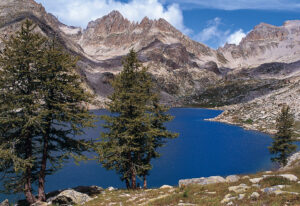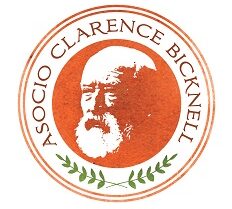 The Vallée des Merveilles, also known in Italian as the Valle delle Meraviglie (Valley of Marvels), is a part of the Mercantour National Park in southern France. It means “the valley of marvels” but most English-speakers use the name in French. The mountainous area, including the valleys of Meraviglie and Fontanalba, together with the towns of Tenda and San Dalmazzo, was part of Italy from 1861 to 1947, and then the region passed France. That is why the places were known by Italian names in the time of Clarence, but are now known by French names. It holds the largest quantity of open-air Bronze Age petroglyphs in Europe, after Val Camonica in Italy, and is given special note for the area’s inclusion for the European Diploma of Protected Areas. The rock engravings are mainly to be found in two valleys, Merveilles and Fontanalba. The first was known already before Clarence, and remains the best known of the two valleys. It was in the second, which Clarence was the first to explore properly, that he made many new discoveries. The valley is located in the rugged mountains of the Argentera massif within the Maritime Alps north of the Italian Riviera.
The Vallée des Merveilles, also known in Italian as the Valle delle Meraviglie (Valley of Marvels), is a part of the Mercantour National Park in southern France. It means “the valley of marvels” but most English-speakers use the name in French. The mountainous area, including the valleys of Meraviglie and Fontanalba, together with the towns of Tenda and San Dalmazzo, was part of Italy from 1861 to 1947, and then the region passed France. That is why the places were known by Italian names in the time of Clarence, but are now known by French names. It holds the largest quantity of open-air Bronze Age petroglyphs in Europe, after Val Camonica in Italy, and is given special note for the area’s inclusion for the European Diploma of Protected Areas. The rock engravings are mainly to be found in two valleys, Merveilles and Fontanalba. The first was known already before Clarence, and remains the best known of the two valleys. It was in the second, which Clarence was the first to explore properly, that he made many new discoveries. The valley is located in the rugged mountains of the Argentera massif within the Maritime Alps north of the Italian Riviera.
Edward Berry (Clarence’s nephew) and his wife Margaret Berry take up the story in their 1931 book “At the Western Gate of Italy” *(1).
“Between the Monte Bego and the Monte Gran Capelet, two giants of the Maritime Alps, lie some small lakes known since about 1520 as the Laghi delle Meraviglie. The name is derived from the extraordinary engravings found on many of the rocks near these lakes, representing figures of which no really satisfactory explanation has yet been found.
“Most of the rocks belong to the Permotriassic formation, and the greater part of those on which the engravings were executed have smooth, flat or rounded, surfaces, polished by the action of the glaciers in the Quaternary Ice Age. The rocks contain a little iron and the surfaces which have been exposed to the air have become weathered, in consequence of which they have acquired a thin patina of yellowish-red colour. The engravings have been made by repeated blows with a pointed tool of stone or metal, the punched holes being so close together that the coloured patina was removed, showing the design on the dark purplish-grey rock and against a background of the more highly coloured patinated surface. The engravings have been so long exposed to the weather that the surface has again become patinated, the result being that it is only on the closest observation that they can be distinguished.
 Photo, left: Edward Berry (Clarence’s nephew), Clarence Bicknell and Margaret Berry on the terrace
Photo, left: Edward Berry (Clarence’s nephew), Clarence Bicknell and Margaret Berry on the terrace
of the Casa Fontanalba during a summer of archaeology, c.1910. For more on the
work of the Berrys download a pdf here.
“The existence of these rock figures must have been known in 1520, to account for the name of the Laghi delle Mereviglie being given to the lakes ion a map of the period, but they do not seem to have attracted the attention of scientists or students of prehistory until an English botanist names Moggridge, resident in Menton, called attention to the special interest of these strange drawings in a paper he read at the International Congress of Prehistoric Archaeology held in London in 1868. Subsequent researches by Rivière, Clugnet and Blanc resulted in the discovery of about five hundred figures. In 1880 Molon made reference to engravings near the “Fontana Alba”, but Celesia, in 1885 and 1886, was the first to describe the engravings of Val Fontanalba, of which he found but a small number.
“It was not until 1897 that Clarence Bicknell, of Bordighera, began a systematic study of them. At the time of his death in 1918 he had discovered, and made heel-ball rubbings of, 7,428 figures in Val Fontanalba, 5,139 in the Meraviglie district, and 151 in the neighbouring valleys. All are to be found within 2kms of Monte Bego.
“There is a great variety of subjects in the engravings, though figures representing horned animals far outnumber the others. The special characteristic of the Monte Bego rock figures is that they are drawn as seen from above and not in profile like those in Sweden and elsewhere…. The scenery in both valleys is grand and impressive, and man seems but a pigmy in the vastness of the great rocky areas above the tree-line, where only patches of grass and a few wind-blown Alpine flowers relieve the monotony of the perpetual stones.
“Bicknell divided the engravings into eight categories: (1) Horned figures. (2) ploughs, (3) weapons, (4) men, (5) huts and properties, (6) skins, (7) geometrical forms, and (8) miscellaneous indeterminable figures. He was the first to observe the drawings of ploughs, harrows or sleighs.
“Owing to its position, Monte Bego is the centre of frequent thunderstorms, and is consequently believed by the peasants to be the seat of an evil spirit who directs the weather. Blanc was so much impressed with the some of the sinister place-names of the district – Cima del Diavilo (Devil’s Paek), Val d’Inferno (Valley of Hell), Valmasca (Witches’ valley) – that he suggested that the possible motive of the engravers in making these figures was the propitiation of some unknown terrible divinity who dwelt on Monte Bego. Bicknell, Barocelli and Burkitt are all inclined to accept this theory as the most probable one.
“Unfortunately, the engravers left no trace of their tools or weapons. And no burial sites have been found in the district. Who they were and whence they came remains an unsolved problem. Every summer, herds of cows are brought up from the plains of Piedmont, and flocks of sheep and goats from the Riviera, to pasture in these Alpine regions. It may be that the forefathers of these same cowmen and shepherds executed the engravings in the dim and distant ages of the prehistoric period.”
Since the Berrys time, further studies have been made by Carlo Conti and Professor Henry de Lumley. But the huge body of work completed by Clarence Bicknell remains as vital to the study of archaeology today as it did a hundred years ago.
The Vallée des Merveilles is now a popular mountain walking destination and the mountain huts are full throughout the summer. The engravings are protected by the Mercantour National Park, which forbids members of the public to leave the officially-designated paths, from which only a few engravings can be seen. But guided visits to many of the engravings within the protected area are available to visitors daily in the summer. Researchers and staff of the Mercantour National Park keep an eye on visitors, from afar, and pop out of the nearby rocks on unsuspecting engraving seekers to announce their presence and to make sure that vandalism is kept to a minimum. The Musée des Merveilles in Tende was set up in the late 1990s to offer tourist a feeling for the valley without having to go there, and to reduce the sometimes unintentional degradation of the engravings in situ.
The mountains are only slowly giving up their mysteries.
Marcus Bicknell April 2013 and Edward Berry 1931
*(1) The Berrys guide book “At the Western Gate of Italy” is subtitled “The Western Italian Riviera: A sketch of its history, art and architecture” and was published in London in 1931 by John Lane and the Bodley Head. My copy was the property of Caroline Packe, Margaret Berry’s sister.

